I was on my forge the other day…correction, my brother’s forge; and working with the anvil…also my brothers. As I punched a hole and shaped a rail spike into a miniature throwing tomahawk for my daughters I looked back on the adventures of my youth. They’ve definitely influenced the way I try and play with my daughters; even if they’d prefer to watch My Little Pony. In their closet is a stack of play things I’ve made for them; actual mini medieval shields, oak longbows with fletched arrows built for their size and strength, a new tomahawk, and other goodies. Unfortunately I have to twist their arms to get them to go outside and play with me; but maybe my son will be more prone to adventure when he gets older.
If you know me then you know that I love history, especially history which we can learn from and apply. Being Danish, my father was obsessed with the romance of the old Wild West. And what foreigner doesn’t love John Wayne and Indians and cowboys, as it was so alien to everything they grow up with. Consequently we found ourselves attending rendezvous, historical reenactments, pow wows, pioneer pageants, and other such events throughout our younger years. I think these events have left endearing memories of good times, clean mountain air, and adventure.
At the time I hadn’t realized how much could be learned from such events, and how much those participants have to teach us. If you ask them about their hobbies they will teach and talk…and talk…and probably talk a little more; a lot like me, which is likely why I get along with those sorts so well. Today I want to draw your attention to the old fur trappers and mountain men the great events still held out west called by the French name, rendezvous (who else but the French would spell it that way). I single these modern events out because it is one of the few places where you can visit and learn from these guys in mass. And while activities like tomahawk throwing probably won’t save your life; learning how to set a snare, clean a rabbit, and tanning fur might.
Before we take a look at the rendezvous let’s read some excerpts about the people which the rendezvous were established for. A mountain man is a trapper and explorer who lives in the wilderness. Mountain men were most common in the North American Rocky Mountains from about 1810 through the 1880s (with a peak population in the early 1840s). They were instrumental in opening up the various Emigrant Trails (widened into wagon roads) allowing Americans in the east to settle the new territories of the far west by organized wagon trains traveling over roads explored and in many cases, physically improved by the mountain men and the big fur companies originally to serve the mule train based inland fur trade.
They arose in a natural geographic and economic expansion driven by the lucrative earnings available in the North American fur trade, in the wake of the various 1806–07 published accounts of the Lewis and Clark expeditions’ (1803–1806) findings about the Rockies and the (ownership-disputed) Oregon Country where they flourished economically for over three decades. With the silk trade and quick collapse of the North American beaver-based fur trade in the later 1830s–1840s, many of the mountain men settled into jobs as Army Scouts, wagon train guides and settlers through the lands which they had helped open up. Others, like William Sublette, opened up fort-trading posts along the Oregon Trail to service the remnant fur trade and the settlers heading west.
Historically Rocky Mountain Rendezvous (in trapper jargon) were an annual gathering (1825–1840) at various locations held by a fur trading company at which trappers and mountain men sold their furs and hides and replenished their supplies. The large fur companies put together teamster driven mule trains which packed in whiskey and supplies into a pre-announced location each spring-summer and set up a trading fair—the rendezvous—and at the season’s end, packed furs out, normally the British Companies to Fort Vancouver in the Pacific Northwest, and to one of the northern Missouri River ports such as St. Joseph, Missouri, if an American overland fur trading company.
Rendezvous were known to be lively, joyous places, where all were allowed- free trappers, Indians, native trapper wives and children, travelers and later on, even tourists who would venture from even as far as Europe to observe the festivities. Jim Beckwourth describes: “Mirth, songs, dancing, shouting, trading, running, jumping, singing, racing, target-shooting, yarns, frolic, with all sorts of extravagances that white men or Indians could invent.”
Rendezvous are still celebrated as gatherings of like-minded individuals or clubs in many walks of life. The fur trading rendezvous are celebrated by traditional black-powder rifle clubs all over the US and Canada. These gatherings range from small gatherings sponsored by local clubs to large gatherings like the Pacific Primitive Rendezvous and others. These gatherings include much of the same activities of the originals, centering around the shooting of muzzle-loaded rifles, trade guns and shotguns, the throwing of knives and tomahawks and primitive archery, as well as cooking, dancing, singing, the telling of tall tales and of past rendezvous. Personas taken on by participants include trappers, traders, housewives, Native Americans, frontiersmen, free-trappers and many others, including soldiers.
If you live in the western United States, look up one of these events and you’re bound to learn and experience something new; and in the least you’ll have a good time watching marksmen split playing cards with muzzle loading muskets. I love the skills of the mid to late 1800s because they are still viable skills to have today. The tools they used are not so far removed as to be useless for survivalists, or just hobbyists.
It is noteworthy that the mountain men and fur traders learned and adapted many of their skills from the natives, as did the early colonialists. The early Americans a broad mix of old and new. Let me share a few paragraphs from the book A Patriots History of the United States in relation to those early Americans:
Life in colonial America was as course as the physical environment in which it flourished, so much so the English visitors expressed shock at the extent to which emigrants had been transformed in the new world. Mane Americans lived in one-room farmhouses, heated only by a Franklin stove, with clothes hung on wall pegs and few furnishings. “Father’s chair” was often the only genuine chair in a home, with children relegated to rough benches or to rugs thrown on the wooden floors.
This rugged lifestyle was routinely misunderstood by visitors as “Indianization,” yet in most cases, the process was subtle. Trappers had already adopted moccasins, buckskins, and furs, and adapted Indian methods of hauling hides or goods over rough terrain with travois, a triangular-shaped and easily constructed sled pulled by a single horse…Whites copies Indians in traveling via snowshoes, bullboat, and dugout canoe. And colonial Americans learned quickly-through harsh experience-how to fight like the Indians.
The American spirit was one of practicality and survival; and we have the chance to continue with that spirit, and to learn and share that knowledge.
Jon
Several paragraphs were taken from various pages of Wikipedia because they offered good summaries.

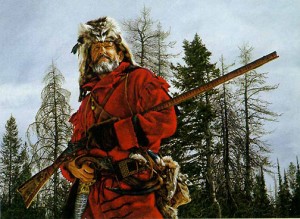


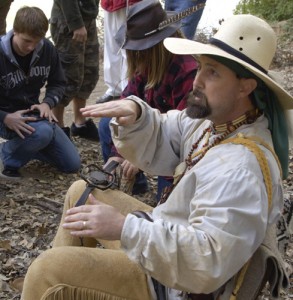
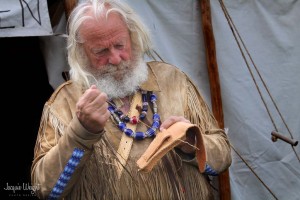
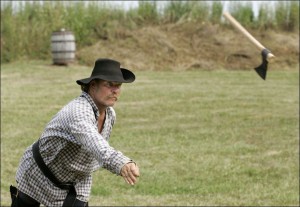
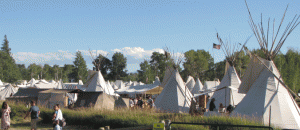
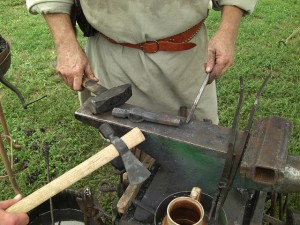
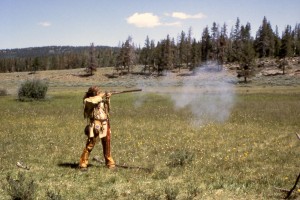
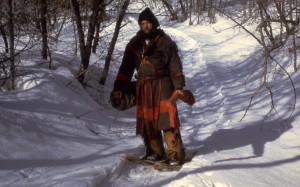
Enjoyed the article, I will be going to my first large rendezvous later this month and will be looking forward to the event.